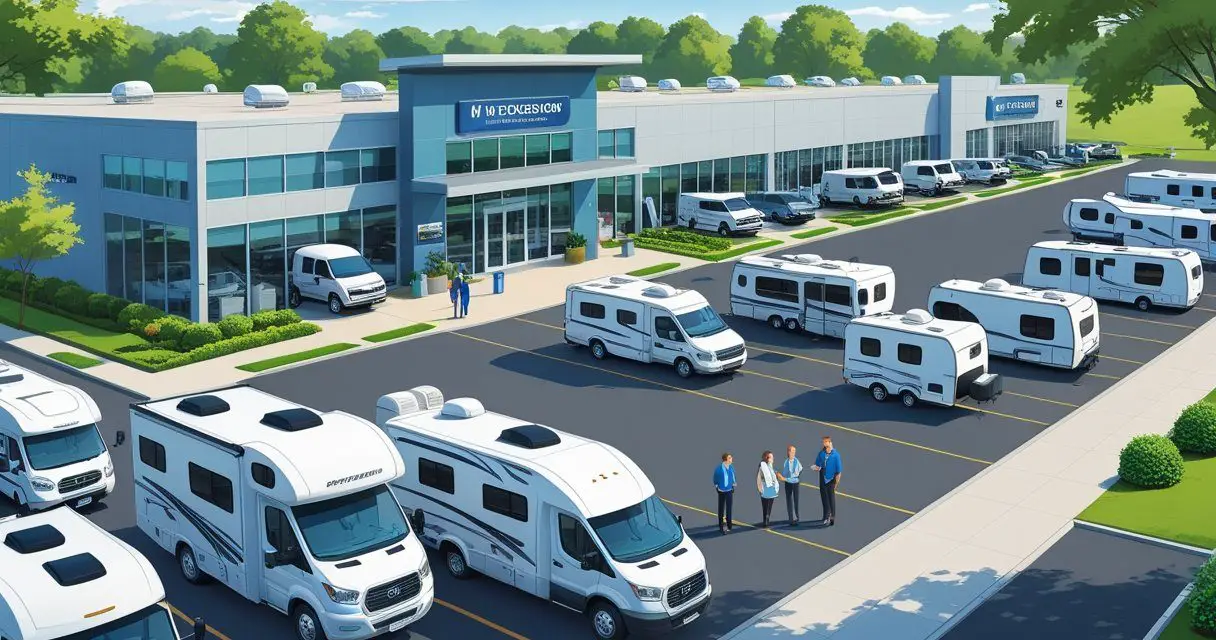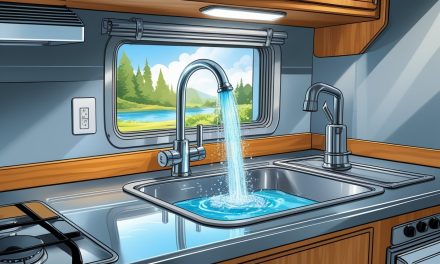Would you like to save this article?
Planning to buy that shiny new RV parked on the dealer’s lot? Hold onto your wallet because what you’re about to discover might change everything. RV depreciation isn’t just a gentle slope downward – it’s more like falling off a financial cliff while blindfolded. The couple in the video above learned this lesson the hard way when their $145,000 Fleetwood Bounder became worth $70,000 less in just four years.
You might think you’re prepared for some value loss, but the reality is far more brutal than most first-time RV buyers imagine. Unlike your house that might appreciate over time, or even your car that loses value predictably, RVs follow their own ruthless depreciation rules. The moment you sign those papers and drive off the lot, you’ve just made one of the most expensive mistakes of your financial life – unless you know exactly what you’re getting into.
1. Your Brand-New RV Loses 20% of Its Value Before You Even Reach the Highway
The instant devastation hits faster than you can say “road trip.” According to J.D. Power, your sparkling new RV loses approximately 20% of its value the moment those wheels roll off the dealer’s lot. That means if you paid $100,000 for your dream rig, you’ve already lost $20,000 before you’ve even filled up the gas tank.
This immediate depreciation hit makes buying a new car look like a smart financial decision in comparison. The depreciation continues relentlessly: after one year, you’re looking at a total loss of 20-25% of your original investment.
| RV Age | Depreciation Rate | Value Lost on $100K RV |
|---|---|---|
| Drive off lot | 20% | $20,000 |
| 1 Year | 20-25% | $20,000-$25,000 |
| 3 Years | 30-35% | $30,000-$35,000 |
| 5 Years | 45-50% | $45,000-$50,000 |
Here’s the kicker: You probably financed most of that purchase, which means you’re paying interest on money that evaporated faster than morning dew. You’ll be making payments on an asset worth significantly less than what you owe – welcome to being underwater on your RV loan from day one.
2. Class A Motorhomes Are the Worst Financial Disasters on Wheels
Class A motorhomes are depreciation champions – and not in a good way. These luxury land yachts lose value faster than a melting ice cream cone in Death Valley. According to Outdoorsy, Class A rigs lose 30% of their value after only three years of ownership.
Your $300,000 diesel pusher becomes a $210,000 rig before you’ve even figured out how to properly level it. The bigger and more luxurious your Class A, the harder it falls in value.
Why Class A’s depreciate so brutally:
- Higher initial cost means larger dollar amounts lost
- Complex systems that become outdated quickly
- Limited buyer pool for expensive used units
- Maintenance costs that scare away potential buyers
You’re essentially paying $30,000 per year just for the privilege of owning that rolling mansion. That’s more than many people’s entire annual salary, and you haven’t even factored in fuel, maintenance, insurance, or storage costs yet.
3. Class C RVs Aren’t Much Better – They’ll Still Crush Your Wallet
Think Class C motorhomes might be your financial salvation? Think again. These supposedly “sensible” RVs still pack a devastating depreciation punch. Research shows that Class C RVs lose 26-27% of their value by year three and 37-38% by year five.
Your $80,000 Class C becomes worth approximately $50,000 in just five years. That’s a $30,000 loss, or $6,000 per year in depreciation alone.
| Class C Age | Depreciation | Value on $80K RV |
|---|---|---|
| 3 Years | 26-27% | $58,400-$59,200 |
| 5 Years | 37-38% | $49,600-$50,400 |
| 10 Years | 51-52% | $38,400-$39,200 |
The brutal reality: You’re losing more money to depreciation than most people spend on their entire annual vacation budget. And that’s assuming you bought smart and negotiated well – many Class C buyers do even worse.
4. Fifth Wheels and Towables Aren’t the Escape Route You Think They Are
Towable RVs seem like the smart money choice, right? Lower initial cost, no engine to maintain, and you can unhitch them at camp. Unfortunately, the depreciation monster doesn’t discriminate. Fifth wheels lose 45% of their value after just five years of ownership, according to industry data.
Travel trailers fare slightly better but still lose approximately 35-40% of their value in the same timeframe. Your $50,000 fifth wheel becomes worth around $27,500 after five years – that’s a loss of $22,500.
The towable trap:
- Lower purchase prices create false sense of security
- Still lose thousands in absolute dollar terms
- Financing costs often exceed depreciation savings
- Storage and maintenance costs add up quickly
You might think you’re being financially responsible by choosing a towable, but you’re still watching thousands of dollars vanish into thin air every single year.
5. Premium Brands Will Crush Your Dreams of “Investment-Quality” RVs
Everyone tells you to “buy quality” and choose premium brands that “hold their value better.” Here’s the truth bomb: even the best RV brands still depreciate like stones falling into water. While Airstream, Jayco, and Winnebago do hold their value relatively better, they still lose massive amounts of money.
An $85,000 Airstream might retain 65% of its value after five years instead of 55% – congratulations, you’ve only lost $29,750 instead of $38,250. That’s still enough money to buy a decent used car.
| Premium Brand | 5-Year Value Retention | Loss on $100K RV |
|---|---|---|
| Airstream | 60-65% | $35,000-$40,000 |
| Winnebago | 55-60% | $40,000-$45,000 |
| Jayco | 55-62% | $38,000-$45,000 |
| Oliver | 65-70% | $30,000-$35,000 |
The “premium brand” myth just means you lose money more slowly, not that you avoid losing money altogether. You’re still hemorrhaging tens of thousands of dollars – just at a slightly more dignified pace.
6. The “5-Year Rule” Is Actually a 7-10 Year Financial Prison Sentence
Financial advisors often suggest the “5-year rule” – keep your RV for at least five years to minimize depreciation impact. But here’s what they don’t tell you: even after five years, your RV continues losing value at a painful rate.
By year 7, most RVs have lost 60% or more of their original value. That means your $120,000 motorhome is now worth $48,000 or less. After 10 years, you might be lucky to get 30-35% of what you originally paid.
The extended depreciation reality:
- Years 6-10: Continued 5-8% annual depreciation
- Major systems start failing around year 7-10
- Outdated technology makes RV less desirable
- Appearance aging accelerates value loss
You’re not just committed to 5 years of depreciation – you’re locked into a decade-long financial slide that doesn’t meaningfully slow down until your RV is essentially worthless.
7. The “Negotiation Safety Net” Is Mostly Fantasy
RV salespeople love to tell you that getting a great deal upfront will protect you from depreciation. “Get 40% off MSRP and you’ll be fine!” they promise. Here’s the harsh reality: even massive discounts often can’t overcome the depreciation steamroller.
Let’s do the math: You negotiate a $200,000 Class A down to $120,000 (a fantastic 40% discount). After three years, it’s worth approximately $84,000 based on typical depreciation rates. You’ve still lost $36,000 despite your amazing negotiation skills.
The negotiation trap:
- MSRP is often inflated to make discounts seem bigger
- True market value may be closer to your “discounted” price
- Depreciation is calculated from purchase price, not MSRP
- Financing costs often exceed any discount savings
Even the best negotiators can’t negotiate their way out of the fundamental mathematics of RV depreciation. You might reduce your losses, but you’re still losing big money every single year.
SOURCES
- J.D. Power – How Much Do Campers Depreciate?
- Outdoorsy – Do RVs Lose Their Value Faster Than Other Vehicles?
- Roamly – Best RV Resale Value 2026: Top Brands That Hold Worth
- Kirkland RV Sales – Used RV Depreciation Factors, Rates, Method
- Progressive – How Does RV Depreciation Work?
- Amped to Glamp YouTube Channel – The real truth about RV depreciation nobody talks about





